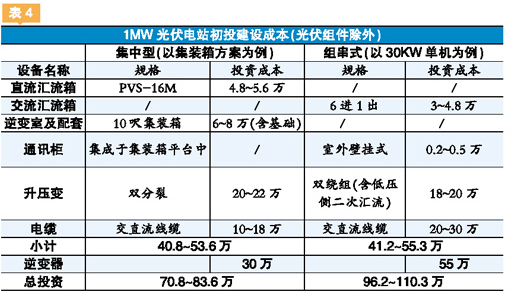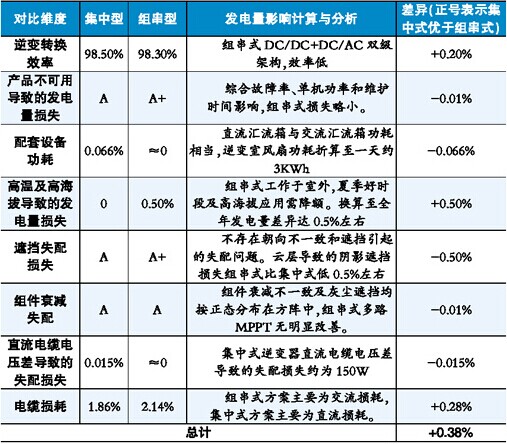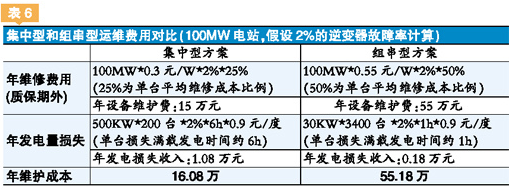Foreword Photovoltaic inverters are one of the two major components of photovoltaic power generation systems. The core task of photovoltaic inverters is to track the maximum output power of photovoltaic arrays and feed their energy into the power grid with the minimum conversion loss and the optimal power quality. Since the inverter is connected in series between the photovoltaic square array and the grid, the choice of inverter will become the key to the long-term reliable operation of the photovoltaic power plant and realize the expected return. This paper proposes "in accordance with local conditions, scientific design" - that is, according to the photovoltaic The size of the power station installed, its environment and grid access requirements, and the reasonable selection of inverter types will maximize the common interests of the power plant constructors, investors, operators, and power grids in terms of safety, stability, and benefits, and promote photovoltaics. The industry is healthy and orderly. I. Classification of photovoltaic power plants and characteristics of power stations According to the different installation environment of photovoltaic power plants, photovoltaic power stations are generally divided into desert power stations, rooftop power stations, and hill power stations. (See Table 1) Desert Power Station: Photovoltaic power station developed using vast flat desert resources. This type of power station is large in scale and generally larger than 5MW. Currently, a single power station with a size of 50MW or more is already common; the power station inverter output is directly fed into the high-voltage transmission network of 110KV, 330KV or higher voltage level after step-up; the environment is flat. The PV modules are oriented in the same direction without obstruction. This type of power station is the main force of China's photovoltaic power stations, mainly concentrated in the western region. Hill Power Station: Photovoltaic power station developed using mountains, hills and other resources. The size of this type of power station varies, ranging from a few MW to hundreds of MW; power generation is mainly integrated into the high-voltage power transmission network; affected by the terrain, there are many components with inconsistent orientations or blocking problems sooner or later. This kind of power station is mainly used in mountainous areas, mines and a large number of wasteland that cannot be planted. Rooftop power station: Photovoltaic power station developed using rooftop resources such as factory buildings, public buildings, and houses. The scale of this type of power station is limited by the effective roof area. The installed capacity is generally from several kilowatts to several tens of megawatts. The power generation of the power station is encouraged to be consumed on the spot and directly fed into the low voltage distribution network or medium and high voltage power grids of 35KV and below; component orientation, dip angle and Shading is diversified. This type of power station is currently the main form of distributed photovoltaic applications, mainly concentrated in China's eastern and southern regions. Second, inverter classification and characteristics Photovoltaic inverters can be divided into three types: centralized inverters, string inverters and micro-inverters, depending on their power levels, internal circuit structures, and applications. (See Table 2) Centralized inverters: The main features are high stand-alone power, low MPPT, and low cost per watt. At present, the mainstream models in China are mainly based on 500KW and 630KW. In Europe and North America, mainstream models have a stand-alone power of 800KW or even higher, and the power level and integration are still increasing. The German company SMA introduced a 2.5MW inverse of the stand-alone power this year. Changer. According to the main circuit structure of the inverter, the centralized inverter can be further divided into the following two types: (See Table 3) Centralized inverters are the first choice for most large-to-medium-sized photovoltaic power plants. In the global 5MW or more photovoltaic power plants, the percentage of their choice is more than 98%. String inverters: The stand-alone power is between 3-60 kW. The mainstream model single machine power 30-40KW, single or multiple MPPT, generally 6-15KW all the way MPPT. This type of inverter has a higher cost per watt and is mainly used for small and medium-sized power plants. The utilization rate of power plants with a capacity of 1MW or less in the world exceeds 50%. Micro-inverter: Stand-alone power below 1KW, single MPPT, application is mostly 0.25-1KW all the way MPPT, its advantage is that it can carry out independent MPPT control for each or several panels, but this type of inverter is High cost. At present, there are many applications in home photovoltaic power stations below 10KW in North America. The typical application of several inverters is shown in the figure. (See Figure 1.) Photovoltaic modules are connected in series to form strings, and multiple strings are connected in parallel to form square arrays. The centralized type connects all string DC sides of a square array to one or two inverters. The number of MPPTs is relatively Less; the string type connects one or more strings to one inverter, one array has multiple MPPTs, and the micro-inverter performs MPPT tracking for each panel. When the components are shaded or inconsistent due to shadows, serial and parallel mismatches occur. The multi-channel MPPT of the string solution can solve the parallel mismatch problem between strings. The micro-inverter can solve the parallel mismatch between strings and can also solve the series mismatch between components. Therefore, from the technical point of view, the essential difference between several inverters lies in the handling of the mismatch problem of components. The design selection based on the inverter needs to find the balance between the total power generation and the total cost in the life cycle of the PV system, and also consider the grid access, such as fault ride-through capability, power quality, and grid adaptability. Claim. According to the characteristics of various inverters, combined with the actual conditions of the applied photovoltaic power plants, scientific and rational selections are made from aspects such as grid friendly, high investment return, and convenient construction and maintenance. Third, the inverter selection guide for different power stations 1. Desert Power Stations - Concentrated advantages Centralized inverters have the following advantages: They are the first choice for desert power stations. Lower initial investment. According to a comparative analysis, the centralized solution saves approximately 260,000 yuan per megawatt on the initial investment compared with the string inverter solution. (See Table 4) The amount of power generation is the same as the string type. In the desert power station, the concentration of centralized and string power generation is basically the same. The integrated concentration type has the advantages of the highest efficiency and overload capacity. The concentrated power generation capacity is slightly higher than the string type. The blocking of the front and back rows of a few power plants that emerged sooner or later could not be overcome by using the string type, and it was necessary to avoid them by optimizing the layout of components. (See Table 5) Operation and maintenance are more convenient and more economical. By comparing the centralized and clustered mainstream models in the operation and maintenance data of the 100MW power plant, the loss of power generation is equivalent to both; since the string-type equipment is the maintenance of the whole equipment, the centralized equipment is the maintenance of the equipment and the maintenance cost of the equipment. The concentrated advantage is obvious. At the same time, in the large-scale 100-MW-class power station that covers an area of ​​several thousand acres, the fully-distributed string inverters will be replaced, and the maintenance staff will spend more time on the road than the equipment replacement time, which is also One of the disadvantages of the string type of large-scale power plant applications. (See Table 6) The centralized plan is more in line with grid access requirements. High-voltage transmission grids have strict requirements on grid-connected photovoltaic power generation in terms of dispatch response, fault traversal, limited emission, super-transmission, smoothing, harmonic limit, power change rate, and emergency start and stop. Fault traversal means that the inverter must be able to output a certain amount of active and reactive power within 625 milliseconds to a few seconds in the event of a short circuit, surge, or phase loss in the power grid, ensuring that the power system relay protection can operate normally. Because the centralized inverter has a small number of stations in the power station, the stand-alone function is powerful, and the communication control is simple. The probability of being able to cross the fault during the fault is far greater than that of the string inverter. In mid-June 2013, on-site low-voltage traverse inspections conducted by the State Grid, several models of centralized inverters also experienced disconnection at different levels. It is assumed that if there are thousands of small inverters operating in large-scale power plants, once the grid fails Due to the complex control of many equipments, the grid coupling and the probability of resonance increase sharply, string inverters will inevitably cause a lot of off-grid and even equipment damage, and endanger the safe operation of the power grid. In addition, due to the large number of inverters, it is impossible to ensure the grid requirements for responding to reactive power dispatch instructions within 30 ms. 2. Hill Power Station - Mainly focused on multi-MPPT solutions, but also consider string type solutions The hill power station can be seen as a desert power station with uneven terrain. It is also mainly fed into the power transmission network, with a size of more than 5MW. In the hill power station project, usually more than 100 KW or so capacity components are planned in a coordinate system (for example, 125 KW components are laid in the same orientation), and the optimal ratio of power generation and investment and maintenance costs is achieved. A multi-MPPT module-based centralized inverter developed for this application tracks more than 100 KW components per MPPT, reducing the design footprint of the same orientation component to approximately 1,000 square meters, greatly improving the construction convenience and effective To solve the problem of facing and obstruction, and at the same time accommodating the output of busbars, it has the characteristics of grid-friendly inverter-friendly power grids and is the first choice for hill power stations. If the terrain of the selected hill power station is very complex, it is very difficult to realize the construction of more than 100 KW components in the same direction. Consider the string inverter as a supplement. 3, roof power station - recommended string type, but also can choose to focus on the type of program The design of the rooftop power station is relatively complex. Affected by the roof size, layout, material weight bearing, and shading, etc., it is necessary to maximize the revenue through component placement and inverter selection planning. At the same time, components are installed on the roof, and fire safety and other safety issues need to be considered. Access to the distribution network, directly close to the user load, need to consider the user's electricity safety, power quality meets the requirements, and the relay protection coordination with the original distribution. After accessing the customer distribution network, the impact on the user's power factor is very obvious. In addition to the active output, the inverter also needs to be quickly based on the real-time power generation status of the PV system, real-time load data of the user, and the original SVC of the user power distribution room. The SVG inputs are comprehensively calculated to determine the real-time reactive power output capacity of the inverter. Therefore, the selection of rooftop PV system solutions requires a balance between safety, grid friendly, return on investment, and maintenance. The roof structure is complex and there is an inconsistent shelter or orientation. The string inverter is recommended. The roof structure is complex. In order to simplify the design, it is recommended to use a string inverter and select the inverter according to the actual roof and grid point location and the voltage level of the grid point. The string inverter needs to have the ability to monitor and shut down the arc, in order to effectively prevent the occurrence of fire, with PID elimination function, with high-precision leakage current protection and island protection. In large-scale factories, centralized solutions can be used in consideration of roof load-bearing and maintenance convenience. The industrial plant has a flat roof, a large scale, less shade, and a simple orientation, and is mostly a 10kV medium voltage distribution network. Taking into account that most of the factory buildings are colored steel roofs, the load-bearing capacity cannot be installed on the string inverters, and the routine maintenance is convenient and does not affect the normal production operations. The centralized inverter may be used. Summary: Inverters as a bridge between components and the grid are the core components of a photovoltaic system. According to the scale of the power station and different application occasions, choosing the right inverter will greatly benefit the system cost and the power generation. In the large-scale, flat desert and tidal flats, centralized inverters are suitable; in large-scale, undulating hilly power stations, multi-MPPT centralized inverters are suitable; they are relatively small and have a variety of layouts. The roofed power station is suitable for string inverters. According to local conditions, scientific selection of PV power plant inverters can ensure that PV power plants do not take detours during the investment decision-making stage, and operate more reliably and efficiently in the later stage of operation and maintenance. (The author is Sunshine Power Co., Ltd.) Towel Ring,Hand Towel Ring,Towel Ring Holder,Bathroom Towel Ring Heshan Zhongxin Sanitary Ware Ind., Co., Ltd , https://www.baolongfaucets.com





